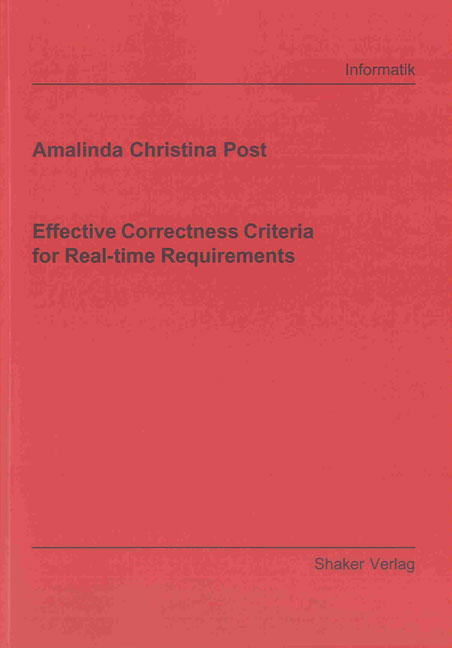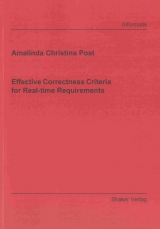Effective Correctness Criteria for Real-time Requirements
Seiten
2012
|
1., Aufl.
Shaker (Verlag)
978-3-8440-0910-1 (ISBN)
Shaker (Verlag)
978-3-8440-0910-1 (ISBN)
- Keine Verlagsinformationen verfügbar
- Artikel merken
In this thesis, we develop a method to automatically analyze automotive real-time requirements for errors. In practice, automotive requirements are mostly analyzed via manual reviews and inspections. However, manual reviews generate high effort, the results are subjective, and although a review can find errors it can never prove their absence. An automatic analysis reduces the effort spent on reviews and assures the quality of the requirements according to objective measures.
To allow an automatic analysis, requirements have to be formalized first—however, formal languages are seldom accessible to stakeholders. To avoid that problem we use an input-language that mimics the syntax of natural language, but has still the mathematical rigor to be interpretable by a tool. We developed three meta-properties of requirements, namely consistency, non-vacuity and rt-consistency, and developed algorithms to check these properties.
We evaluated the method in a case study on 16 sets of requirements for components taken from automotive projects at BOSCH. The results indicate that the effort for the formalization is acceptable, that the algorithms are feasible in principle, and that the benefit is high. Even though the requirements had passed a thorough review, our method detected errors in 8 of 16 sets of requirements. For 6 components the method could prove consistency, rt-consistency and non-vacuity.
To allow an automatic analysis, requirements have to be formalized first—however, formal languages are seldom accessible to stakeholders. To avoid that problem we use an input-language that mimics the syntax of natural language, but has still the mathematical rigor to be interpretable by a tool. We developed three meta-properties of requirements, namely consistency, non-vacuity and rt-consistency, and developed algorithms to check these properties.
We evaluated the method in a case study on 16 sets of requirements for components taken from automotive projects at BOSCH. The results indicate that the effort for the formalization is acceptable, that the algorithms are feasible in principle, and that the benefit is high. Even though the requirements had passed a thorough review, our method detected errors in 8 of 16 sets of requirements. For 6 components the method could prove consistency, rt-consistency and non-vacuity.
| Erscheint lt. Verlag | 4.4.2012 |
|---|---|
| Reihe/Serie | Berichte aus der Informatik |
| Sprache | englisch |
| Maße | 148 x 210 mm |
| Gewicht | 186 g |
| Einbandart | Paperback |
| Themenwelt | Informatik ► Software Entwicklung ► Requirements Engineering |
| Mathematik / Informatik ► Informatik ► Theorie / Studium | |
| Schlagworte | automatic requirements analysis • Automotive • Real-Time Systems • Requirements |
| ISBN-10 | 3-8440-0910-8 / 3844009108 |
| ISBN-13 | 978-3-8440-0910-1 / 9783844009101 |
| Zustand | Neuware |
| Haben Sie eine Frage zum Produkt? |
Mehr entdecken
aus dem Bereich
aus dem Bereich
Aus- und Weiterbildung nach IREB-Standard zum Certified Professional …
Buch | Hardcover (2021)
dpunkt (Verlag)
CHF 41,85
Produkte und Prozesse nachhaltig verbessern
Buch (2023)
Hanser (Verlag)
CHF 55,95




